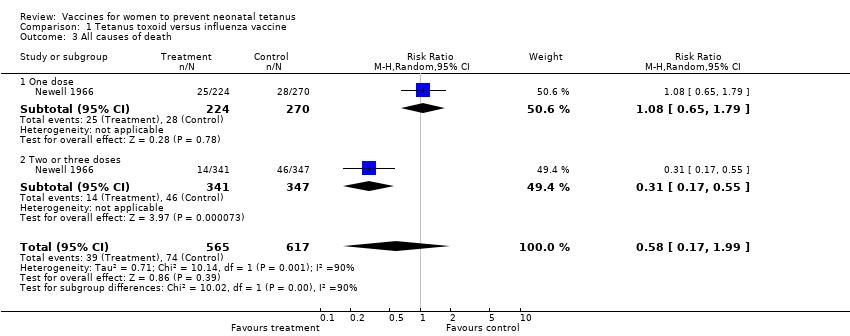| References | Design | Study Population | Treatment | Outcomes | Results |
| Baltazar 1994 | Case‐control study. | 54 neonates admitted to hospital diagnosed with neonatal tetanus. 50
controls 1‐4 months old admitted for causes other than neonatal tetanus.
Manila. | Immunisation with tetanus toxoid, considered immunised if received at least 2 doses of tetanus toxoid during pregnancy, otherwise not. | Incidence of immunisation: cases (1/54), controls (12/49). | Protective effect against neonatal tetanus if at least 2 doses of tetanus toxoid. |
| Chai 2004 | Case‐control study.
Surveillance data after TT mass immunisation campaign carried out 1995‐96 in 320 out of 560 countries reaching about 23 million women aged 18‐35 years, were also reported. Coverage with 2 doses of TT was estimate 10%. Surveillance data of 1996‐2001 were analysed. | Cases: 60 children with NT (WHO case definition) reported by cards and hospital record in Bobai country (province of Guangxi, China) to the National Notifiable Disease Reporting System (NNDRS) from 1.1.97 to 30.4.98. Only children with accurate locating information were included. Controls: 60 infants born in the same village as the cases. | Mother of children were immunised with TT. No information about the number of administered doses is reported. | TT immunisation status of the mothers and other informations (maternal: age, education level, annual income < 1000 Yuan; infant: gender, order of birth, home delivery; parental knowledge and attitude regarding NT) were assessed by means of a detailed questionnaire given to parents of both cases and controls. TT immunisation history was based only of mother's recall because they were not provided with vaccinal records. Mothers of 7 cases and 17 controls received previously TT. | Receiving of 1 or more of TT was significant protective against NT. Maternal age, education, family income, birth order, parental knowledge, were also significantly associated with NT. |
| Gupta 1998 | Survey. | 1688 pregnant women. India. | Immunisation with tetanus toxoid, considered immunised if received 2 doses of tetanus toxoid at at least 4 weeks apart or a booster dose. Partially immunised, if received 1 dose of tetanus toxoid either during the current pregnancy or in the past 3 years. | Deaths from neonatal tetanus within 3 to 30 days of birth. | Immunisation during the antenatal period is highly protective against occurrence of neonatal tetanus. |
| Hlady 1992 | Case‐control study. | Infants with clinical diagnosed tetanus. 3 controls. Bangladesh. | Immunisation with tetanus toxoid, 2 doses 4 weeks apart, with second dose administered at least 30 days before delivery. | Incidence of immunisation: cases (33/112), controls (122/336). | Immunisation failed to provide the expected high level of protection. |
| Ysuf 1991 | Follow‐up survey. | Women aged 10‐45 years. Indonesia. | Immunisation with tetanus toxoid, 1 or 2 doses. | Deaths from neonatal tetanus within 3 to 28 days of birth. | Immunisation caused an 85% reduction of neonatal tetanus. |
| Chongsuvivatwong 1993 | Survey study. | Women aged 15‐45 years. Thailand. | Immunisation with tetanus toxoid. | Cases of neonatal tetanus. | Immunisation caused a 8‐10 times reduction of neonatal tetanus. |
| Rahman1982 | Surveillance study. | Women from surveillance area. Bangladesh. | Immunised with tetanus toxoid at 6th, 7th, 8th month. Considered immunised if received 2 injections in 1974 or in the 1978‐79 programme.
Partially immunised, if received 1 injection in 1974 or 1978‐79.
Mixed immunised if received 1 or 2 doses in 1974 and again 1 or 2 doses in 1978‐79. | Deaths attributed to neonatal tetanus within 4‐14 days after birth. | Full immunisation reduced neonatal mortality rates by about one half and mortality rates on days 4‐14 by about 70%. |
| Koenig 1998 | Survey. | Children between 1‐14 years and non‐pregnant women at least 15 years. Bangladesh. | Immunised with cholera toxoid (1 or 2 0.5 ml doses) vs tetanus ‐ diphtheria toxoid (1 or 2 0.5 ml doses). | Deaths attributed to neonatal tetanus within 4‐14 days after birth. | 2 injections provided significant protection. Protection of 1 dose not significant. |
| Schofield 1961 | Observational. | Pregnant women from 62 villages in New Guinea (Maprik, Wingei and Wosera areas). A retrospective "history‐taking survey" on children born from 1945 to the time of the study was also performed in the Maprik area. | 3 doses of fluid formalinised tetanus toxoid (Commonwealth Serum Laboratories, Melbourne). The first dose was administered as early as possible in pregnancy, the second 6 weeks later and the third between 6 weeks and 6 months after the second. | Cases of neonatal tetanus observed in children born from mothers who received different number of doses of TT during pregnancy.
Not immunised: 8/86.
Once immunised: 8/74.
Twice immunised: 8/234.
Three times immunised: 1/175.
From the history‐taking survey it results that during the examination period 184 deaths due to neonatal tetanus occurred out of 3017 live births. | 3 doses of formalinised TT administered during pregnancy afforded substantial protection against neonatal tetanus. Immunisation with only 2 doses provided also a significant protection level. No reactions to the vaccine were noticed. |







